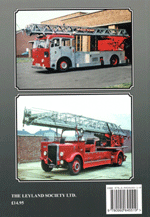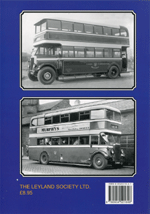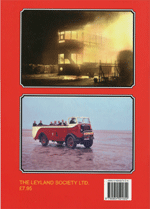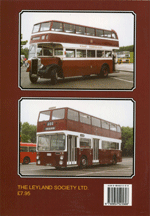| |
Leyland Fleet
Series
The Leyland Fleet Series of books, available to the
general public are a high quality publications
focusing not just on the vehicles but on the
companies and organisations that operated them. The
intention is to present the reader with new facts
and photographs, and to try to show some of the
influences that shaped the products of Leyland
Motors.
|
 |
|
The Leyland
Lion (1930s)
This SECOND volume completes the story
of the pre-war Leyland LT series Lion and
the associated Lioness and Tigress models,
together with the LION CUB and CHEETAH..
Full details are included of all the
domestic and exported Lion models (LT1 to
LT9) and Cheetahs (LZ1 to LZ5) plus the
other models up to 1940. The LIONESS and
TIGRESS models have never been covered in
detail before due to difficulties in trying
to obtain detailed information.
This A4 sized book runs to 88 pages PLUS the
cover (which is in colour), and contains
OVER 200 photographs, most of which will not
have been seen before. They include many
from the magnificent archive of Leyland
official photographs which are now held at
the British Commercial Vehicle Museum in
Leyland, together with photographs from both
authors’ own personal collections, the
Leyland Society archive, and individual
photographers.£20.00 including postage. For a order form
click here.
|
|

 |
|
Leyland Fire
Engines - 1942-1993
This volume is the final one of three
covering fire appliances covered, mainly at
Chorley, Lancashire by Leyland Motors Ltd.
This book is a sequel to that written by our
friend the late Neil Steele in 2003 and
covers the wartime and post-war period for
the next 50 years, up to the introduction of
Leyland-DAF chassis.
£14.95 including postage. For a order form
click here. |
|

 |
|
Leyland Fire Engines - 1909-1930
This volume is the second of three covering
the fire appliances produced, mainly at
Chorley, Lancashire by Leyland Motors Ltd.
The book is a prequel to that written by our
friend, the late Neil Steele in 2003, and
covers the beginnings of fire appliance
production, continuing up to the
introduction of the LTBI Lioness Six range,
which is where Neil began his account. While
the range of appliances produced took some
time to become established Leyland soon
became one of the two most successful and
most respected manufacturers in the British
Empire and beyond.
Simon Ryan writes the text in his third year
of inoperable cancer and hopes that the book
is one which Neil would have been proud of
if things had been different — Neil had
originally intended to be involved with Mike
to write this volume.
Mike Sutcliffe started the whole thing off
with his detailed 'hands-on' knowledge of
very early Leylands and comprehensive
collection of Leyland material. The first
job was to attempt to list all the pre-1930
Leyland Fire Engines from records he has
been collecting since 1956, detailing all
the model changes and culminating in a
record of about 99% of these machines,
despite few formal records surviving. These
are detailed in the book.
The book runs to 72 pages including the
cover (which is in colour), Perfect Bound,
size B5 (240mm x 170mm) and contains over
100 photographs, most of which will not have
been seen before. They include many from the
magnificent archive of Leyland official
photographs which are now held at the
British Commercial Vehicle Museum in
Leyland, together with photographs from both
authors' own personal collections, the
Leyland Society archive and the Merseyside
Fire and Rescue Service Heritage and
Education Centre. £14.95 including postage. For a order form
click here. |
|

 |
|
The Leyland
Lion (Origins to 1929)
The Leyland LSC Lion was introduced in 1925
and built up to 1929, more commonly known as
the PLSC, and had an important place in the
story of the British motor bus. It
popularised the idea of a medium-sized
single-decker designed as such from the
ground upwards more broadly than any other
type of that era. It offered a clear
improvement over previous standards of
travel for passengers and attracted orders
from a wide variety of operators, large and
small, usually with standardised bodywork.
It incorporated a lower-built frame and had
a brisk performance, a model well-liked and
reliable in service. The remainder of the
range, the Leveret and Leviathan models, are
also included in this book so as to complete
the history of the “L” model range.
The book is a joint effort by Alan Townsin
and Mike Sutcliffe MBE, produced to a very
high standard. It is the usual size for our
Fleet Series, but with 72 pages on high
quality gloss art paper, with 100 superb
quality photographs and with a laminated
cover in colour, in fact, it’s the best of
our Fleet Books so far produced!
£14.95 including postage. For a order form
click here. |
|

 |
|
Edinburgh
Corporation
Edinburgh Corporation (and its successors,
Lothian Region Transport and Lothian Buses)
is the first Scottish operator to be covered
in this series. Their earliest Leyland buses
were used to support the tramway system and
vehicles of this make later comprised a
significant proportion of the fleet in the
years following the replacement of trams in
the early 1950s. Apart from the tour fleet,
this situation continued until the marquee
was no longer available. This publication
was written by Gavin Booth and Mike
Sutcliffe, both experts in their respective
fields, and contains much new information on
the earliest Leylands and details of postwar
demonstrators and ‘look-alike’ vehicles with
other operators. The book is the standard
size for our Fleet Series, has 48 pages on
high quality gloss art paper, with 68 superb
photographs, and with the laminated cover in
colour.
£9.95 including postage. For a order form
click here.
|
|

 |
|
Plymouth City
Transport
Ron Phillips latest book takes us away from
the North West to the South West, to the
city where the father of the late Lord
Stokes was General Manager of the Tramways
Dept and first introduced buses in the
1920's. His son Donald went to work as an
apprentice at Leyland Motors in the 1930's
when Plymouth's trams were replaced by
Leyland Buses. By the time war broke out the
city's buses were all Leyland. After the
war, Leyland buses were re ordered again,
following the wartime Guy Utility buses, and
continued until 1982. The book is well
written, very readable and packed full of
interesting detail. Very well illustrated
with numerous black and white photographs.
£8.95 including postage. For a order form
click here. |
|

 |
|
The Leyland Buses of Burnley Colne & Nelson
The book tells the story of the Leylands
purchased by The B.C.N Joint Committee,
which was a stalwart customer for chassis
and bodywork built in Lancashire. Despite
some major problems encountered in the
1930's and the difficult terrain and traffic
patterns, the mainly Leyland municipal fleet
served the three towns well.
£8.95 including postage. For a order form
click here. |
|

 |
|
Ribble Double
Deck Coaches
This new 48 page illustrated publication in
the "Fleet Series" tells the story of the
double deck coaches of various style
operated by Ribble Motor Services. First the
"White Ladies", Titan PD1 chassis with
Burlingham or East Lancs lowbridge double
deck bodies, which were used on medium
distance express services. Next, and
somewhat avant garde, were the Atlantean
"Gay Hostess" coaches for motorway services,
and the Series II "White Ladies", all based
on the PDR1/1 chassis which the Ribble
company came to reject for ordinary service
work. Finally, there were the Leyland-engined
Bristol VRLL double deck motorway service
coaches, which the manufacturer rejected,
and which had quite a short service life.
The book, which is well illustrated with
pictures of which many are previously
unpublished, tells the story of these
vehicles with Ribble and after sale, and
contains much information taken from both
Ribble and Leyland Motors records.
£8.95 including postage. For a order form
click here. |
|

 |
|
Leyland Fire
Engines - 1930-1942
Leyland's first fire engine was supplied in
1909 to the City of Dublin. Production of
fire engines continued until 1930 when
Leyland paused to consider whether or not to
continue building expensive machines usually
tailored to the requirements of individual
Chief Fire Officers.
The decision was to continue with a new
series of machines based on the Leyland
Tigress and Leyland Cub chassis - the FT and
FK series, built between 1930 and 1942. All
fire engines produced by Leyland in this
period are described and listed in this 64
page, fully illustrated book by Neil D.
Steele. which also explains in detail many
features of fire engine design and
operation.
£8.95 including postage. For a order form
click here. |
|

 |
|
Leigh
Corporation
The Leyland Buses of Leigh Corporation not
only chronicles the municipal bus fleet but
also the Leigh-Bolton trolleybus service of
South Lancashire Transport Company which
used a fleet of special Leyland-built
trolleybuses. Leigh Corporation began bus
operation in 1920, and most vehicles
purchased were Leylands. The fleet size was
doubled in the early years of the Second
World War to serve a large Royal Ordnance
Factory. An unusual reason for the operation
of low-height double deckers was the low
height of the depot in Holden Road, and
abandonment of the SLT trolleybuses forced
Leigh to become the operator of Dennis
Lolines, although it was also the last
municipal purchaser of Leyland Lowbridge
buses. The book is well illustrated and
contains a map and fleet list.
£8.95 including postage. For a order form
click here. |
|

 |
|
Southport
Corporation
The bus fleet in the seaside town of
Southport was renowned for its smart
appearance and special beach bus service.
The Leyland Buses of Southport Corporation
by Ron Phillips tells the story of the bus
fleet, mainly Leyland, including a small
number of locally built Vulcan buses as well
as four-wheel drive Bedford beach buses,
until it was absorbed by Merseyside PTE in
1974.
Chapter headings include: Southport
Corporation Tramways, Replacing the Trams,
The Southport Livery, Ladies Only, The Air
Raid Precautions Bus, Toastracks, Sea Cars &
Runabouts, The "Farington" Leylands, The
Open-toppers, One Man Operation & The
Corporation's Depots.
£7.95 including postage. For a order form
click here. |
|

 |
|
Wigan
Corporation
With 48 glossy pages, the book contains many
previously unseen and unpublished
photographs, drawing extensively both on the
BCVM archive and the wealth of knowledge and
material within The Leyland Society itself.
Written by Ron Phillips, The Leyland Buses
of Wigan Corporation tells the story both of
the history of this much admired municipal
undertaking and the development of the
Leyland buses that it bought.
Chapter titles include - Wigan Corporation
Tramways, Early Buses, The First Leylands,
Replacing the Trams, Diesel versus Petrol,
Fleet Expansion, The Wartime Period, 75
Replacement Buses, Royal Tigers and Tiger
Cubs, The Central Depot, Front Entrance
Double Deckers, The Panther Cubs, Rear
Engined Double Deckers, The Panthers and a
Summary of Leyland Bus Orders.
£7.95 including postage. For a order form
click here. |
|
|